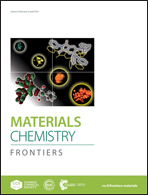Side chain engineering on dithieno[3,2-b:2,3-d]pyrrol fused electron acceptors for efficient organic solar cells†
Abstract
Two novel dithieno[3,2-b:2,3-d]pyrrol fused electron acceptors (FREAs) with branched alkyl side-chains have been developed. With 2-ethylhexyl and 2-butyloctyl introduced on the N-position of the pyrrol unit, the sidechain engineered acceptors (INPIC-EH and INPIC-BO) were evaluated for organic solar cells (OSCs) by comparison with our reference INPIC-4F bearing a linear octyl chain. The optoelectronic properties of the FREAs and their bulk-heterojunction (BHJ) with a PBDB-T donor for OSCs are systematically studied. All FREAs exhibit similar absorption spectra and energy levels. Notably, the charge dissociation process, charge mobility, and morphology of the BHJ films make a distinct difference. Consequently, the OSCs constructed with INPIC-EH and INPIC-BO delivered a power conversion efficiency (PCE) of 11.9% and 11.2%, lower than that of INPIC-4F devices (13.1%). The lower short-circuit current density (JSC) and fill factor (FF) of INPIC-EH and INPIC-OB based devices are attributed to unfavorable morphology of the active layers and more bimolecular recombination and unbalanced charge transport. Our investigation demonstrates that side-chain engineering on FREAs has a great impact on the morphology of blends and thus the photovoltaic properties of their OSCs.
![Graphical abstract: Side chain engineering on dithieno[3,2-b:2,3-d]pyrrol fused electron acceptors for efficient organic solar cells](/en/Image/Get?imageInfo.ImageType=GA&imageInfo.ImageIdentifier.ManuscriptID=C8QM00669E&imageInfo.ImageIdentifier.Year=2019)


 Please wait while we load your content...
Please wait while we load your content...